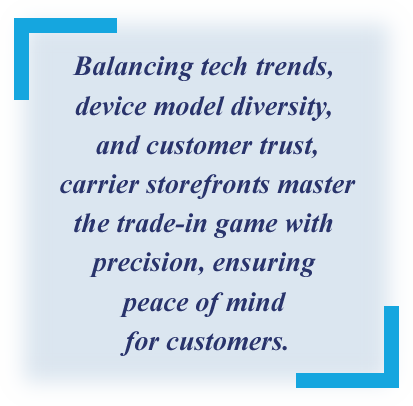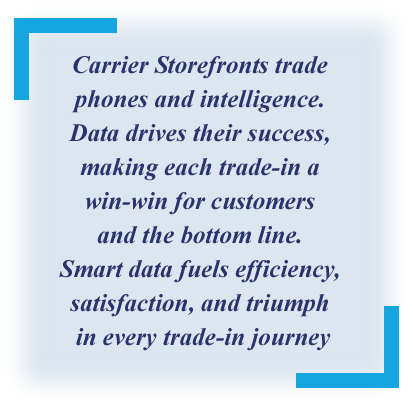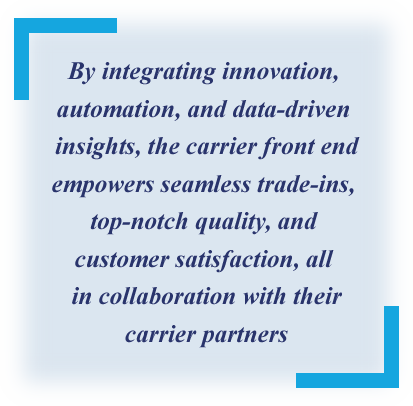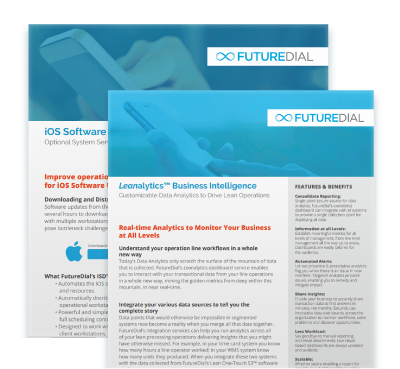The FutureDial Blog
(10.09.2023)

![]()
TAKEAWAY: In the competitive mobile phone market, brick-and-mortar storefronts operated by wireless carriers play a pivotal role, actively engaged in providing customers with the latest phone models and facilitating trade-ins for older ones. These preowned trade-in devices collected at the storefronts subsequently find their way into the back-end ecosystem for resale in secondary markets.
This article marks Part 5 of a comprehensive nine-part series, delving into the front-end operations of wireless carriers and their integral role in handling phone trade-ins to supply the expansive backend ecosystem.
PART 5: The Front End of Wireless Carriers Handling Preowned Smartphones in the Mobile Device Ecosystem
![]()
For the purpose of our discussion here, the “Wireless Carrier Front-End” denotes a carrier that not only owns its network but also operates physical brick-and-mortar storefronts on the front-end as a primary revenue stream, largely centered around service contracts.
Their profitability is further enhanced by providing customers with the latest phones through various contract agreements. To ensure competitive pricing for these cutting-edge devices, they also offer trade-in options to customers.
It’s worth noting that, for these Wireless Carrier Front-End stores, phone trade-ins are a means to an end. The subsequent handling of collected devices and transactions falls under the purview of another branch within the wireless carrier’s organization, typically located on the back-end, such as warehouses or third-party partner device processing centers.
1. How the Carrier Front-End Collects Preowned Mobile Phones:
The collection of preowned mobile phones by Carrier Front-End Stores, represented by brick-and-mortar storefronts of major wireless carriers, involves several aspects that are crucial to their operations. Here’s a description of how these stores typically collect preowned mobile phones:
1. Collecting Preowned Phones from End-Users:
Carrier Front-End Stores actively encourage customers to trade in their existing mobile phones. This process often begins when customers visit the store to inquire about upgrading to a new device or changing their service plan.
Staff at these stores may initiate conversations about the customer’s existing phone, discussing its model, condition, and age. If the customer expresses interest in upgrading, they are encouraged to trade in their old phone as part of the transaction.
2. Buyer’s Remorse & Warranty (Returns & Exchanges):
 These storefronts also handle cases of “buyer’s remorse,” where customers may have recently purchased a new phone and subsequently changed their minds. Many wireless carriers offer a return or exchange policy within a specific timeframe, often accompanied by a restocking fee. In such cases, the returned phones are categorized as preowned and collected by the store.
These storefronts also handle cases of “buyer’s remorse,” where customers may have recently purchased a new phone and subsequently changed their minds. Many wireless carriers offer a return or exchange policy within a specific timeframe, often accompanied by a restocking fee. In such cases, the returned phones are categorized as preowned and collected by the store.
Additionally, phones under warranty that require replacement may also be collected at these stores. These phones are typically sent back to the carrier’s service center for refurbishment or recycling.
3. Trade as Incentive to Sell More New Devices:
Offering trade-in incentives is a common strategy used by Carrier Front-End Stores to boost sales of new devices and service plans.
Customers are enticed to trade-in their old phones in exchange for discounts, bill credits, or other incentives towards the purchase of a new device. This approach not only benefits customers but also keeps the inventory of preowned devices flowing into the store.
Importantly, Carrier Front-End Stores often accept a wide range of devices, regardless of their resale potential. This includes older models, phones with minor defects, or even non-functional devices. The goal is to create a seamless and convenient experience for customers while ensuring that they continue to use the carrier’s services and acquire the latest phone technology.
4. Collection and Processing:
Once preowned phones are collected, they are carefully inspected and assessed. This evaluation includes checking for physical damage, functionality, and cosmetic condition. This can initially take place in-store with a basic inspection, and/or the devices may be sent on to another location where the inspection work is carried out more thoroughly.
Devices that meet specific criteria for resale are refurbished, wiped of personal data, and prepared for resale either in-store or through online channels. Phones that are not suitable for resale may be recycled or responsibly disposed of to minimize environmental impact.
In summary, Carrier Front-End Stores play a pivotal role in collecting preowned mobile phones from end-users, and regardless of their resale potential, the trade-ins serve as both an incentive to sell new devices and contribute to the carrier’s sustainable practices, ensuring responsible disposal and recycling when necessary.
2. Preowned Mobile Device Processing Considerations by the Carrier Front-End:
Handling and processing preowned mobile device trade-ins at the storefronts can be complex and involves various considerations regarding about how these storefronts manage this process, taking into account the wide variety of device models and conditions, as well as the accuracy of warranty failure verification:
1. Variety of Device Models and Conditions:
Carrier Front-End Stores deal with a broad spectrum of mobile device models, ranging from the latest flagship smartphones to older, less common models. These devices come in various conditions, including pristine, gently used, damaged, or even defective or non-functional. Some may exhibit minor cosmetic issues, while others might have more severe physical damage. To accommodate this wide variety, carrier storefronts must have robust processes and infrastructure in place. This includes having dedicated staff trained to assess device condition accurately and efficiently.
2. Scalability with Technology Trends and Seasonal Volume:
The mobile device market is highly influenced by technology trends and seasonal variations, such as new product releases, holiday shopping seasons, or special promotions. Accordingly, Carrier Front-End Stores must be prepared to handle fluctuations in device trade-in volumes. This means having the capacity to process a large number of devices during peak periods and adjusting staffing levels as needed.
Additionally, the processing infrastructure should be flexible and scalable to accommodate changes in device models and technology, ensuring that new models are seamlessly integrated into the trade-in process.
 3. Accuracy of Warranty Failure Verification:
3. Accuracy of Warranty Failure Verification:
One critical aspect of trade-in handling is the accurate verification of warranty status. It’s essential to ensure that devices traded-in are not under warranty or subject to warranty claims. Carrier stores typically use databases and systems provided by the carrier to verify warranty status of devices that are brought into the store. This verification process helps prevent customers from trading-in devices that can still be serviced or replaced under warranty.
Accuracy is paramount in this verification process, as errors could lead to financial losses for the carrier or inconvenience for customers. To enhance accuracy, staff are usually trained to follow specific procedures, and systems are regularly updated to reflect the latest warranty information.
4. Data Security and Privacy:
Another crucial consideration in the trade-in process is data security and privacy. Preowned devices often contain personal data and sensitive information. Stores must have strict protocols in place to ensure that all customer data is wiped from traded-in devices securely. This may involve using specialized software tools or services to perform complete data erasure. Compliance with data protection regulations and customer trust are essential aspects of this process.
As described above, storefronts must consider managing a wide variety of device models and conditions while ensuring scalability to accommodate changing technology trends and seasonal volume fluctuations. Accurate warranty verification is critical to prevent warranty abuse, and robust data security measures are needed to protect customer privacy during the trade-in process. Meeting these considerations is vital to the success of trade-in programs and ensuring a positive customer experience.
3. Downstream Selling of Preowned Mobile Devices by The Carrier Front-End:
The downstream selling of preowned mobile devices by Wireless Carrier Front-End Stores involves several intricate processes, including bulk sales via auctions, rigorous device clearance, testing, and grading, as well as the strategic use of “seed stock” for warranty replacements. Here’s a description of these aspects:
1. Bulk Sales via Auctions:
Wireless carriers often gather a surplus of preowned mobile devices from trade-ins and other sources. They may opt to sell these devices in bulk through auctions, either online or through specialized wholesale auctions. Bulk sales offer efficiency by moving many devices at once, potentially cutting storage expenses and generating revenue.
2. Clearance, Testing, and Grading:
Preowned mobile devices are rigorously cleared, tested, and graded before auction or sale. Clearance ensures secure data erasure, testing evaluates hardware functionality, and grading categorizes devices into conditions like “Like New,” “Good,” or “Fair,” with noted cosmetic issues.
3. “Seed Stock” for Warranty Replacements:
“Seed stock” comprises high-quality preowned devices labeled “Like New,” used as reliable warranty replacements to provide customers with near-new devices when original devices encounter problems.
4. Quality Assurance:
Throughout these processes, quality assurance checks are typically done at every stage, including data clearing, testing, grading, and seed stock selection. Devices not meeting quality standards are recycled or responsibly disposed of to maintain environmental and ethical standards.
4. How the Carrier Front-End Utilizes Intelligent Data in their Phone Handling Operations:
Wireless Carrier Front-End storefronts leverage intelligent data throughout their phone trade-in handling and resale operations to streamline the end-to-end process, enhance accuracy, handle variability, and implement complex conditional “if-then” business rules that guide the handling and disposition of the devices. Here are some examples of how they utilize intelligent data for these aspects:
 1. Accurate Identification at the Point of Collection (At-Home & In-Store):
1. Accurate Identification at the Point of Collection (At-Home & In-Store):
Intelligent data is crucial for accurately identifying and categorizing preowned phones, whether collected in-store or through at-home programs. In stores, staff use specialized software or apps to identify device details, vital for trade-in values and promotions. In at-home trade-ins, customers input information through online forms or apps, with intelligent data algorithms verifying accuracy and establishing initial trade-in values.
2. Accuracy upon Receiving (Customer-Facing Accuracy like Credits):
When preowned phones are received at the store or at a back-end processing center, intelligent data systems continue to play a role in maintaining accuracy. Customer-facing aspects, such as accurately calculating trade-in credits, depend on the data-driven assessment of the device’s condition and model. This ensures that customers receive the correct value for their trade-in. Accuracy in this step is crucial to maintain trust with customers and prevent disputes over trade-in values.
3. Variability – Handling the Wide (and Complex) Process with Precision (Dynamic Testing):
The variability in device models, conditions, and trade-in scenarios requires intelligent data systems to adapt dynamically. Dynamic testing protocols may be employed, where the data-driven system tailors the testing process based on the device’s known characteristics and condition. For example, a high-value device may undergo more rigorous testing, while a device with known defects may be tested for specific issues.
4. Assigning Devices for Downstream Channels:
Intelligent data allows storefronts to make informed decisions about which devices should be designated for various downstream channels right from the moment they arrive. This means that devices can be earmarked for resale, bulk auctions, warranty replacement stock, or recycling based on their condition and potential value. Data-driven insights also help carriers optimize inventory management and maximize revenue by directing devices to the most profitable channels.
5. Complex “If-Then” Conditional Business Rules:
Wireless Carrier Front-End Stores often operate under complex conditional business rules that dictate how devices are handled, valuated, and processed. Intelligent data systems are essential in automating and managing these rules efficiently and uniformly across all stores. For instance, if a device meets specific criteria, it may be automatically routed for refurbishment, while others may be destined for recycling. Data analytics help carriers continually refine these rules to optimize their trade-in and resale operations.
Intelligent data is the backbone of Wireless Carrier Front-End storefronts’ phone trade-in handling and resale operations. By leveraging intelligent data, these storefronts can enhance customer satisfaction, optimize profitability, and ensure the smooth flow of preowned devices through their trade-in and resale processes.
5. Real-World Challenges that the Carrier Front-End Faces in Handling Preowned Mobile Devices:
Handling preowned mobile devices presents Carrier Front-End storefronts with several real-world challenges that they must address to ensure efficiency and customer satisfaction. Two key challenges include:
1. How to Achieve Consistency Across Multiple Third-Party Logistics Providers (3PLs):
Carrier Front-End stores often work with several 3PLs to handle trade-ins and resales. The challenge arises from each 3PL having its own processes and capabilities, making it tough to maintain consistency and quality. To overcome this, stores should establish clear, standardized processes, documentation, and quality controls applicable to all 3PLs. Effective communication and routine performance evaluations ensure alignment with carrier standards and objectives.
2. Improving Process Visibility and KPI Metrics:
Achieving a clear view of the entire trade-in and resale process, from device collection to final steps, is challenging but crucial. Real-time visibility is needed to track individual devices, quality control, and identify any issues or bottlenecks. Carrier Front-End Stores invest in advanced tracking systems using RFID, barcoding, or GPS to provide real-time data on device status and location. Key Performance Indicators (KPIs) are vital for measuring success, covering metrics like processing times, trade-in value accuracy, customer satisfaction, and inventory turnover. Implementing comprehensive analytics and reporting tools helps aggregate data for actionable insights and addresses this challenge.
Some Additional Challenges:
a. Data Privacy and Security: Managing and protecting customer data during the trade-in process to comply with data protection regulations.
b. Quality Control: Ensuring consistency in grading and testing devices to maintain customer trust and prevent disputes.
c. Seasonal Variability: Handling fluctuations in device volumes during peak seasons, product launches, or special promotions.
d. Environmental Responsibility: Meeting sustainability goals by responsibly recycling or disposing of devices that cannot be resold.
6. How the Carrier Front-End Approaches Innovation and Automation for their Phone Handling and Processing Operations:
Carrier Front-End storefronts, in collaboration with the back-end organization of wireless carriers, adopt innovation and automation strategies to enhance their phone trade-in handling, processing, and resale operations. Here’s a description of their approach:
1. Integration of Third-Party Logistics Providers (3PLs):
Carrier Front-End stores collaborate with multiple 3PLs for phone trade-in and resale tasks. These 3PLs handle device processing and refurbishment. The challenge is to maintain consistent quality across all 3PLs, ensuring standardized, high-quality refurbished smartphones. To tackle this, wireless carriers set strict quality standards, maintain clear communication channels with 3PLs, and provide detailed guidelines on device handling, refurbishment procedures, and quality control.
2. Automation for Consistency and Scalability:
Automation is a central component of achieving consistency in product quality across various 3PL partners and ensuring scalability in operations. It is recognized that automated systems help streamline and standardize processes, reducing the potential for human error and ensuring uniform quality.
Here’s how automation is typically applied at different stages:
a. Device Assessment and Grading:
Automated tools aid in accurately assessing traded-in phone conditions. These tools can help the in-store staff who are inspecting the trade-in phones to identify and categorize issues such as screen damage, battery health, and device software performance.
b. Data Erasure and Factory Resets:
Automation is used to securely wipe customer data from traded-in devices, ensuring data privacy and compliance with regulations. Factory reset procedures are automated to reset devices to their original settings.
c. Refurbishment and Repair:
The Front-End Store later sends the trade-in phones to the back-end processing warehouses or to 3PL partners for further refurbishing or repair work. Once there, automated assembly lines and robotics are used for precision replacement of damaged components like screens, buttons, or batteries.
d. Quality Control and Testing:
Stores can use apps and tools for automated functional testing of trade-in devices. These tests assess both hardware and software functionality, ensuring devices meet established quality standards.
3. Flexibility and Ease of Transition:
Automation guarantees consistency and flexibility in working with different 3PL partners. Carriers can seamlessly switch between partners, adapting to market changes, device volumes, or onboarding new partners with minimal disruption.
4. Data-Driven Insights:
Automation systems gather data throughout trade-in and refurbishment. Analytics and machine learning are used to detect trends, enhance processes, and boost product quality. These insights empower carriers to make data-driven decisions and refine quality standards.
7. Where the Carrier Front-End Experiences Wasted Opportunities in their Phone Handling Operations:
Carrier Front-End storefronts, while managing phone trade-in handling and resale operations, often encounter wasted opportunities in critical areas. These missed opportunities can affect efficiency, consistency, brand reputation, and overall profitability. Here are key aspects where such wastage occurs:
1. Reducing Over-Reliance on Human Decisions:
Overreliance on human decisions, especially for complex rules, can lead to inconsistencies and biases in assessing and valuing trade-in devices, impacting product quality and the customer experience. Automation and data-driven decisions can eliminate these problems, ensuring a consistent and unbiased approach to device handling and valuation. The missed opportunity is not fully leveraging automation to ensure quality consistency and boost brand reputation, which are vital for resale success.
2. Scalability Challenges:
Carrier Front-End stores often miss opportunities when it comes to handling fluctuations in sales volumes driven by device releases and seasonal trends. Seasonal spikes can strain back-end operations like warehouses and 3PL centers, leading to bottlenecks and inefficiencies. The missed opportunity lies in not proactively scaling operations and resources to manage these fluctuations better. Implementing temporary staff, flexible automation, and streamlined processes during peak seasons can help stores capitalize on increased trade-ins without overloading the back end. Failing to do so can result in missed revenue opportunities and customer dissatisfaction due to processing delays.
3. Data-Driven Insights Utilization:
Storefronts often gather abundant data during the trade-in and refurbishment process but may not fully utilize it. Data-driven insights offer valuable information on customer behavior, device conditions, and process efficiency. However, missing opportunities involve not analyzing and acting upon this data effectively. These include not using data insights to improve conditional rules, streamline grading processes, or identify trends for informed marketing and pricing strategies.
4. Customer Engagement and Loyalty:
While focusing on trade-in and processing operations, Carrier Front-End storefronts sometimes miss opportunities to engage customers more effectively. Engaging customers with educational content about the trade-in process, offering transparency in valuations, and providing incentives for trading in devices can enhance customer satisfaction and loyalty. By fostering a positive customer experience, storefronts can potentially encourage repeat business and referrals, ultimately contributing to long-term profitability.
8. How the Carrier Front-End can Streamline their Resale Operations for Preowned Phones:
Streamlining trade-in handling and resale operations for preowned phones is critical for Carrier Front-End storefronts to enhance efficiency, customer satisfaction, and reputation. Achieving this requires a focus on better visibility, automated insights, and accuracy throughout the process. Here’s a detailed description of how these aspects can be improved:
1. Enhanced Visibility:
Visibility is vital for identifying bottlenecks and tracking progress. Real-time tracking allows monitoring from acceptance to credit issuance. Key milestones, like package receipt, assessment, valuation, and credit issuance, should be accessible to all, enhancing transparency, setting clear expectations, and reducing uncertainty.
2. Automated Insights for Issue Resolution:
Automated insights are crucial for addressing trade-in and resale process issues. For example, delayed packages trigger alerts for quick investigation. Notifications and alerts can rectify discrepancies in device assessments, promptly identifying and resolving deviations from promised trade-in values. These proactive measures prevent customer satisfaction problems by addressing issues before they escalate.
3. Accuracy of Device Condition Assessments and Trade-In Valuations:
Device assessment accuracy and trade-in valuations are pivotal for maintaining end-user trust. Automation employs standardized criteria and algorithms for objective condition assessments. Advanced diagnostic tools and machine learning algorithms enhance assessment precision. Transparent, automated valuation systems generate precise trade-in values based on actual device condition, preventing discrepancies. Regular audits and quality checks further boost accuracy.
4. Customer Communication and Feedback:
Effective communication with end-users is crucial in trade-in and resale. Automated notifications track progress, while post-trade-in surveys gather satisfaction insights. Analyzing feedback to refine processes improves the trade-in experience.
5. Continuous Process Improvement:
Carrier Front-End storefronts should embrace a culture of continuous process improvement. Data-driven insights and automation provide valuable information for identifying process bottlenecks, areas of inefficiency, and opportunities for optimization. Regularly reviewing and refining processes based on these insights can lead to more streamlined operations and improved customer experiences over time.
9. What Do the Carrier Front-End Stores Consider when Embracing Change in the Way They Handle Preowned Mobile Devices?
When Carrier Front-End storefronts contemplate embracing change in the way they handle preowned mobile device trade-ins and renewal processing for later resale, they take several key considerations into account. These considerations encompass evolving customer engagement dynamics and adapting to technological advancements. Here are the aspects they weigh:
1. Changing Customer Engagement Dynamics:
Front-end management closely monitors shifts in how end-user customers engage with the wireless carrier company. This involves understanding whether customers are increasingly opting for online channels over in-person visits to conduct trade-ins and phone upgrades. Considerations include:
a. Customer Preferences: Are more customers choosing online platforms for convenience and efficiency? Is there a shift in the desire for digital interactions?
b. User Experience: How can the trade-in and renewal process be optimized for online users, ensuring a seamless and user-friendly experience?
c. Staffing and Resources: If in-person visits decrease, how does this impact staffing levels and resource allocation in physical storefronts?
d. Online Security: What measures are in place to safeguard online trade-in transactions and customer data?
2. Adapting to Evolving Technology:
The wireless industry is characterized by rapid technological advancements in mobile devices. Front-end management needs to ensure that their trade-in device processing can adapt to these changes. Considerations include:
a. New Device Features: How will the trade-in process accommodate new features, such as advanced cameras, biometrics, foldable screens, and 5G capabilities?
b. Device Model Form Factors: With varying device form factors, including traditional smartphones, tablets, wearables, and emerging form factors, how can the processing workflow be flexible and adaptable?
c. Software Updates: Addressing changes in operating systems, firmware updates, and app compatibility that may impact the trade-in and refurbishment process.
d. Sustainability Initiatives: Considering the growing emphasis on sustainability, how can device recycling and responsible disposal be integrated into the process?
3. Technological Infrastructure:
Management assesses their technological infrastructure to determine whether it can support the anticipated changes. Considerations include:
a. Digital Transformation: Does the storefront have the necessary digital tools and platforms to support online trade-ins and upgrades?
b. Data Management: How is customer data handled and secured in accordance with data protection regulations?
c. Automation: Can automation technologies streamline the trade-in assessment, grading, and valuation processes for efficiency and consistency?
d. Integration: Are there plans to integrate with carrier back-end systems, 3PL partners, and online marketplaces to ensure a seamless end-to-end trade-in experience?
4. Training and Staff Development:
Management considers the importance of training and upskilling staff to adapt to changing customer engagement dynamics and technological advancements. Considerations include:
a. Training Programs: Developing training programs that equip staff with the necessary skills to facilitate online trade-ins and handle new device technologies.
b. Customer Interaction: Providing guidance on how to effectively engage with customers in both online and in-person settings.
c. Technology Proficiency: Ensuring staff are proficient in using digital tools and platforms that support trade-in processing.
10. Are Warehouse Management Systems Obsolete for the Carrier Front End?
The relevance and obsolescence of Warehouse Management Systems (WMS) for Carrier Front-End storefronts in the wireless industry are influenced by several factors. While these storefronts may not directly operate such warehouse systems, they are still impacted by the choices made by their hired third-party logistics (3PL) partners. Here are the key aspects to consider:
1. Third-Party Logistics (3PL) Partners:
Wireless Carrier Front-End stores often subcontract device processing and management to 3PL partners. The 3PL usually owns and runs the WMS, freeing the storefronts to concentrate on their core business of selling wireless devices and services.
2. Dependency on Specific 3PL Partners:
Some wireless carriers may initially depend on specific 3PL partners for their trade-in and refurbishment operations. However, over time, they may reevaluate this dependency for various reasons:
a. Consistency Across 3PLs: Wireless carriers may seek more consistency in the quality of service and refurbishment processes across different 3PL partners.
b. Operational Flexibility: The need to have the flexibility to move processing operations and device inventory between 3PLs or to consolidate them back into the wireless carrier’s operations may arise.
c. Strategic Control: Wireless carriers may decide to bring certain aspects of the trade-in and refurbishment process in-house to have more control over operations and quality standards.
3. Evolving Business Needs:
As the wireless industry changes, Carrier Front-End stores must adapt to evolving customer preferences, technology, and competition. Depending on their strategy and goals, they may reconsider their reliance on certain 3PL partners and the role of WMS in the process.
4. Technology Integration:
WMS primarily belongs to 3PLs, but seamless operations require tech integration between carrier storefronts and 3PLs. This involves data sharing, real-time tracking, and communication systems for mutual visibility in the trade-in and refurbishment process.
The Role of Automation in Optimizing Preowned Mobile Device Collection Operations for the Carrier Front-End:
Automation plays a pivotal role in optimizing preowned mobile device collection operations for Wireless Carrier Front-End stores. By automating various aspects of the trade-in process, these stores can enhance efficiency, accuracy, and customer satisfaction. Key takeaways regarding the role of automation in this context include:
1. Efficiency and Consistency: Automation streamlines device assessment, grading, and valuation processes, reducing manual effort and minimizing the potential for human errors. This results in consistent and standardized trade-in operations.
2. Customer Experience: Automation offers end-users a seamless and user-friendly experience when trading in their devices. It enables real-time tracking, transparent communication, and faster processing times, improving overall customer satisfaction.
3. Operational Scalability: Automation allows Carrier Front-End stores to adapt to fluctuating trade-in volumes, such as seasonal peaks, by efficiently processing a large number of devices without compromising quality.
4. Data-Driven Insights: Automation generates valuable data insights that inform decision-making, process optimization, and quality control. It enables continuous improvement by identifying trends and areas for enhancement.
5. Integration with Technology: Automation systems are adaptable to evolving device technologies, ensuring that the trade-in process can accommodate new features, form factors, and software updates.
6. Flexibility and Control: Automation provides the flexibility to adapt to changing customer engagement dynamics, whether customers prefer in-person or online trade-in options. It also grants storefronts more control over the process.
Automation is a cornerstone of efficient and customer-centric preowned mobile device collection operations for Wireless Carrier Front-End stores. It empowers these stores to meet the demands of a dynamic industry, deliver a superior customer experience, and remain competitive in the ever-evolving wireless market. As technology continues to advance, embracing automation will be essential for staying at the forefront of the wireless device trade-in and resale business.
![]() Profit-Boosting Solutions for the Carrier Front-End
Profit-Boosting Solutions for the Carrier Front-End
Wireless carriers have consistently turned to FutureDial as their trusted business partner, leveraging cutting-edge automation solutions to streamline the processing of preowned mobile devices. These enhancements not only fine-tune their business operations but also elevate their overall profitability.
Whether you’re a wireless carrier, wholesaler, refurbisher, 3PL, MNO, MVNO, reseller, trade-in provider, or any vital part of the mobile device supply chain, FutureDial is your strategic ally for success in this competitive market. Contact us at sales@futuredial.com today to unlock the potential of our innovative solutions for your business.
Coming Up:
Don’t Miss PART 6 of our Backend Ecosystem Review, describing the role of Mobile Phone Trade-in Providers supplying the Preowned Mobile Device Market.
© 2023 FutureDial Incorporated. All Rights Reserved.

